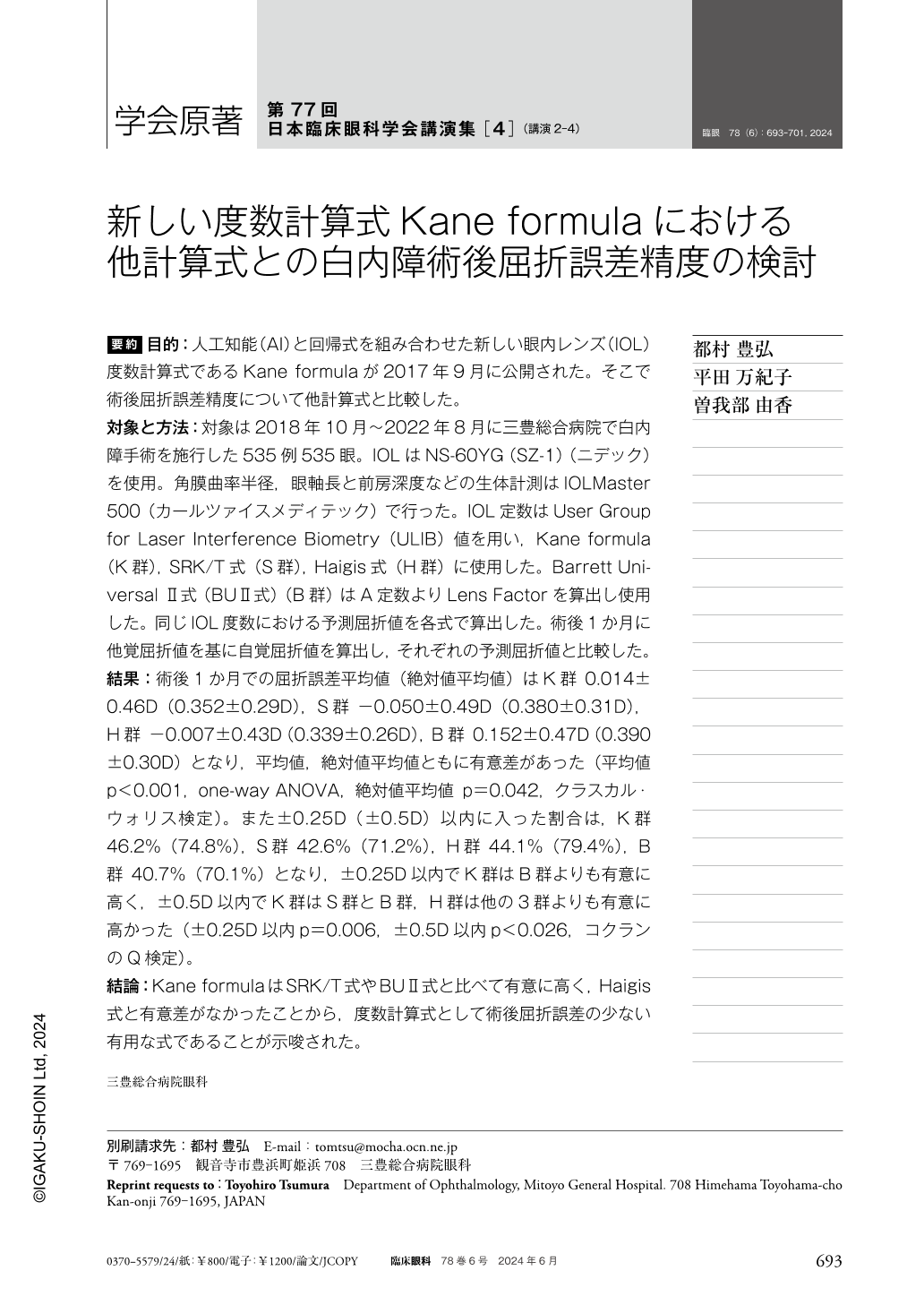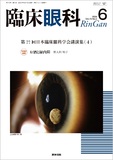Japanese
English
- 有料閲覧
- Abstract 文献概要
- 1ページ目 Look Inside
- 参考文献 Reference
要約 目的:人工知能(AI)と回帰式を組み合わせた新しい眼内レンズ(IOL)度数計算式であるKane formulaが2017年9月に公開された。そこで術後屈折誤差精度について他計算式と比較した。
対象と方法:対象は2018年10月〜2022年8月に三豊総合病院で白内障手術を施行した535例535眼。IOLはNS-60YG(SZ-1)(ニデック)を使用。角膜曲率半径,眼軸長と前房深度などの生体計測はIOLMaster 500(カールツァイスメディテック)で行った。IOL定数はUser Group for Laser Interference Biometry(ULIB)値を用い,Kane formula(K群),SRK/T式(S群),Haigis式(H群)に使用した。Barrett Universal Ⅱ式(BUⅡ式)(B群)はA定数よりLens Factorを算出し使用した。同じIOL度数における予測屈折値を各式で算出した。術後1か月に他覚屈折値を基に自覚屈折値を算出し,それぞれの予測屈折値と比較した。
結果:術後1か月での屈折誤差平均値(絶対値平均値)はK群 0.014±0.46D(0.352±0.29D),S群 −0.050±0.49D(0.380±0.31D),H群 −0.007±0.43D(0.339±0.26D),B群 0.152±0.47D(0.390±0.30D)となり,平均値,絶対値平均値ともに有意差があった(平均値 p<0.001,one-way ANOVA,絶対値平均値 p=0.042,クラスカル・ウォリス検定)。また±0.25D(±0.5D)以内に入った割合は,K群 46.2%(74.8%),S群 42.6%(71.2%),H群 44.1%(79.4%),B群 40.7%(70.1%)となり,±0.25D以内でK群はB群よりも有意に高く,±0.5D以内でK群はS群とB群,H群は他の3群よりも有意に高かった(±0.25D以内p=0.006,±0.5D以内p<0.026,コクランのQ検定)。
結論:Kane formulaはSRK/T式やBUⅡ式と比べて有意に高く,Haigis式と有意差がなかったことから,度数計算式として術後屈折誤差の少ない有用な式であることが示唆された。
Abstract Purpose:To report refractive errors after cataract surgery with implantation of an intraocular lens(IOL)using the Kane formula, which was released in September 2017, and other formulas.
Cases and Methods:This study involved 535 eyes of 535 patients who received cataract surgery from October 2018 to August 2022. Actual refraction was measured one month after surgery and was compared with the value predicted using the Kane formula, SRK/T, Haigis, and Barrett Universal Ⅱ(BUⅡ)formula.
Results:Refractive error one month after surgery averaged(absolute averaged)0.014±0.46D(0.352±0.29D)for Kane formula, −0.050±0.49D(0.380±0.31D)for SRK/T, −0.007±0.43D(0.339±0.26D)for Haigis, and 0.152±0.47D(0.390±0.30D)for BUⅡ. Both the mean and absolute values were significantly different(p<0.001, one-way ANOVA;p=0.042, Kruskal-Wallis test). The frequency of refractive error within±0.25D(±0.5D)was 46.2%(74.8%)for the Kane formula, 42.6%(71.2%) for SRK/T, 44.1%(79.4%)for Haigis, 40.7%(70.1%)for BUⅡ. Within±0.25D, the Kane formula was significantly higher than BUⅡ. Within±0.5D, the Kane formula was significantly higher than SRK/T and BUⅡ. And Haigis was significantly higher than the other three formulas(within±0.25D:p=0.006;within±0.5D:p<0.026, Cochran's Q test).
Conclusion:The Kane formula was the most useful formula with less postoperative refraction error in IOL calculation.

Copyright © 2024, Igaku-Shoin Ltd. All rights reserved.


